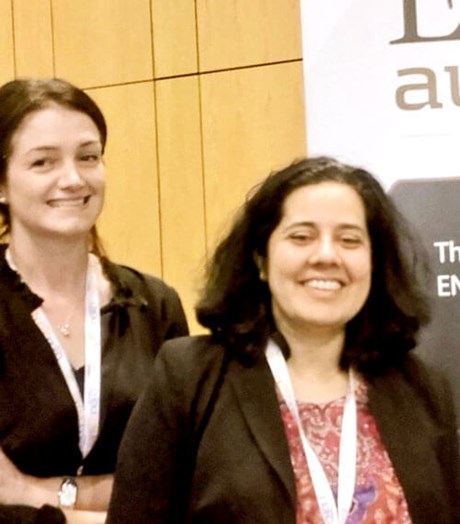
Sujana S Chandrasekhar,
MD, Past President, AAO-HNS/F;
Secretary-Treasurer, American Otological Society;
Consulting Editor, Otolaryngologic Clinics of North America;
Recipient, AAO-HNS WIO Helen Krause Trailblazer Award
and AMA Physician Mentor Recognition Award.

Emma Stapleton
Consultant Otolaryngologist,
Cochlear Implant and Skull Base Surgeon,
Manchester Royal Infirmary, UK.
E: emmastapleton@doctors.org.uk
Twitter: @otolaryngolofox
Women have advanced from nearly no representation in otolaryngology to a significant minority today. In the United States, 0.3% of practising otolaryngologists were women in 1963; by 2015, 15.8 % of the 9405 practising otolaryngologists were women, a and of the 1472 active olaryngology trainees in the US that year, 36.3% were women [1]. But things are not as rosy as these numbers would make it seem. Even entering the ‘pipeline’ appears more difficult for women; in Canada in 2013, only eight out of 16 (50%) female applicants versus 19 out of 25 (75%) male applicants, for whom their first choice was otolaryngology, matched into it [2].

Emma and Sujana visiting the ENT & Audiology News stand at CHOLE2016.
Once inside, achieving leadership is also tough. In the US, 12 years ago there were four female chairs of otolaryngology (4/104 departments - 3.8%); now there are six (6/117- 5%) [3]. A fifth of the surgeons in England are women, as are 43% of the otolaryngology trainees, but only 12% of all consultant surgeons are women [4]. In Nigeria, the ratio of male to female otolaryngology trainees is 4.7:1 [5]. Of all 25,000 surgeons in India, there are only 700 women surgeons [6]. The Women in Otolaryngology-India Facebook page is followed by 59 people, not all of whom are Indian women ENTs.
As is expected, roles in leadership lag behind as a group first enters a field, initially in small numbers and then as a sizeable minority and as the existing leaders grow to accept the possibility of an ‘outsider’ becoming a leader. This sentiment is pervasive in all fields, not only in medicine. Male leadership styles often do not ‘fit’ well with women leaders, and therefore the woman who gets a leadership chance is often criticised for her style, whether or not she achieves results [7].
And, finally, once there is one, or perhaps a handful, of women in a given leadership position, the male majority will often ‘decide’ that there has been plenty of representation and go back to ‘business as usual,’ generally excluding people who are not of the majority (gender, race, sexual orientation, disability, etc.) until the pendulum by nature swings back. But women have achieved high positions in ENT. What makes these women leaders tick? What gets them to those positions? There is a pressing need to understand and help the next groups of women advance further. The Sep/Oct series of articles are interviews of women leaders in otolaryngology from around the world. We hope you will find their answers as illuminating as we did.
References
1. Friedman R, Fang CH, Zubair M, Kalyoussef E. Women’s role in otolaryngologic medicine. Bulletin of the American College of Surgeons.
http://bulletin.facs.org/2016/12/
womens-role-in-otolaryngologic-medicine/
Last accessed August 2019.
2. Chorfi S, Schwartz JS, Verma N et al. Evolution of gender representation among Canadian OTL-HNS residents: a 27-year analysis. J Otolaryngol Head Neck Surg 2017;46(1):55.
3. Chandrasekhar S. Women in Otolaryngology: Do we belong here? ENT Today.
www.enttoday.org/article/
women-in-otolaryngology-do-we-belong-here/
Last accessed August 2019.
4. Moberly T. A fifth of surgeons in England are female. BMJ 2018;363:k4530.
5. Adoga SA, Ma’an ND, Adekwu A, et al. Otorhinolaryngology postgraduate training in Nigeria: Trainees perspective. Journal of Health Research and Reviews in Developing Countries 2018;5(1):48-56.
6. Sagar S. Women in Surgery: A perspective from India. Association of Women Surgeons
www.womensurgeons.org/news/
386437/Women-in-Surgery-A
-perspective-from-India.htm
Last accessed August 2019.
7. Johnson JT. Women in Otolaryngology. J Otolaryngol Head Neck Surg 2014;43(1):14.
A number of groups exist for women in ENT and surgery. We have included some here should you wish to read more about them:
Women in ENT Surgery (WENTS)
www.entuk.org/wents
Women in Otolaryngology (WIO)
www.entnet.org/content/women-otolaryngology-section
Women in Surgery (WinS)
www.rcseng.ac.uk/careers-in-surgery/women-in-surgery
Association of Women Surgeons (AWS)
www.womensurgeons.org
Click here for the articles
Leadership: in conversation with Dr Joyce Aswani
Sujana Chandrasekhar
The otolaryngologist as hospital director: a view from Thailand
Nadtaya Mills
Leadership and maximising resources: the view from Brazil and Venezuela
Norma de Oliveira Penido
European power women in otolaryngology: a focus on Laura Viani, Ireland’s first female otolaryngologist
Elinor Warner
Beyond ‘sticky floors’ and ‘glass ceilings’: eight women department and society leaders share their stories
Sujana Chandrasekhar





